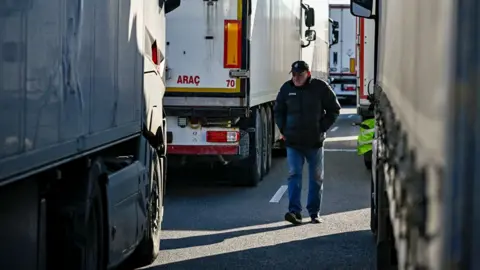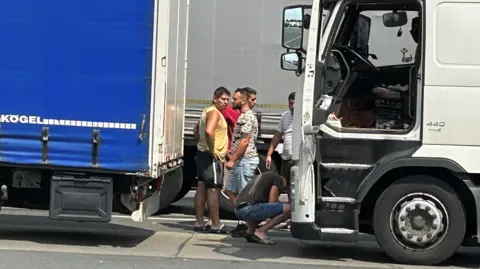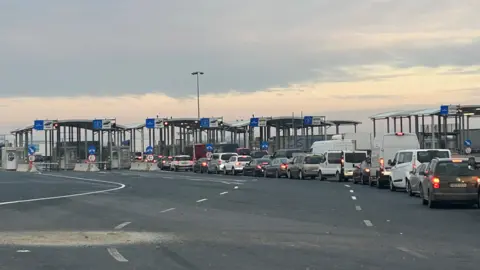Time to relax as Romania and Bulgaria join the EU's borderless zone

 Getty Images
Getty Images17 years after Romania and Bulgaria joined the European Union, they have been given the green light to become members of its Schengen border-free travel area.
A decision by EU member states means that from 1 January 2025, you will be able to drive all the way to France, Spain or Norway without a passport.
It is a moment of great relief for the 25 million people who live in Romania and Bulgaria, and who will finally feel welcomed as full members of the EU. President of the European Commission Ursula von der Leyen said it was “a happy day”.
Although border checks were lifted on air and sea travel between the two countries last March, it was only last month that Austria raised its opposition to ending land border checks.
But for truck drivers, the border enforcement is not over yet.
Hungary it looks like it will continue to check each truck and its documents for at least six months at the main Romanian-Hungarian border in Nadlac.
In Bulgaria built a new lorry park and electronic barrier in Ruse, near the bridge across the Danube to Romania, charging €25 (£20) per lorry.
And “temporary” border controls have been installed across the continent, with countries fearing a rise in illegal immigration.
 BBC/Nick Thorpe
BBC/Nick ThorpeThe Schengen area became a reality in 1985 and now includes many EU countries, as well as some non-EU countries, including Norway and Switzerland.
The UK has never been in Schengen, although visitors from the UK can currently visit the area without a visa for up to 90 days every 180 days.
Hungarian and Romanian border police were embarrassed when I crossed from Hungary to Romania hours before the EU announcement.
“We will get the details tomorrow,” said the Hungarian official shyly.
And the devil may lie in the details.
Ovidiu Dabija headed for the border this morning after steering his SUV with a 31ft long Sterk boat from a yard in Timisoara, a large city in western Romania.
He drives a powerboat from his home in Germany to one boat show after another. Last week he was in Athens. Next week he will head to the manufacturer's site near Nuremberg.
“Romania joining Schengen will save me hours when I cross the border,” he tells me on the side of Nadlac.
“Our drivers lose at least 12 hours at each border,” said Radu Dinescu, head of the Romanian Road-Haulers' Association. “The worst wait was five days at the Hungarian-Romanian border.”
He estimates that Romania's road transport industry has lost €19bn between 2012 and 2023 due to border delays. That increased the prices consumers ended up paying.
“The ones who will benefit the most from January 1 will be cars and private people,” said Dinescu, although they will still be regulated in a random manner.
 BBC/Nick Thorpe
BBC/Nick ThorpeFor trucks, he doesn't believe there will be much of a difference soon.
A major concern for truckers is that all truck inspections occur at the border, from scales to permits and cargo inspections, sanitary and environmental inspections, and illegal immigration searches.
In some countries already within the Schengen area, such checks take place quickly and efficiently in dedicated car parks away from the border.
Radu Dinescu blames the successive governments in Romania for failing to negotiate with the country's neighbors, in order to remove the pressure on the borders.
He cites EU legislation from 2008 that requires weight and size controls on trucks to prevent them from crossing borders between EU member states.
That has never been used on the Romanian-Hungarian border or on the Romanian-Bulgarian border, due to competition between rival inspectors.
It's not just about trade, but also investment, says the head of the Romanian Road-Haulers' Association.
While BMW was trying to choose between Hungary and Romania as a location for a new car factory, the wait at the Romanian-Hungarian border increased inexplicably.
BMW then chose the Hungarian city of Debrecen.
Dacia Renault, Romania's largest car manufacturer, is facing continuous delays in the delivery of parts delivered at the Schengen borders. “I don't want to underestimate the importance of our world borders joining Schengen, but there is still work to be done,” said Dinescu.
In Timisoara, Philip Cox of Romania's largest wine merchant, Cramele Recas, is optimistic.
“Border control will take time to wither,” he believes, “but it will happen, maybe in six months, because it interests everyone.”
And that will make his wines more competitive in western and northern European markets, he believes.
Source link




